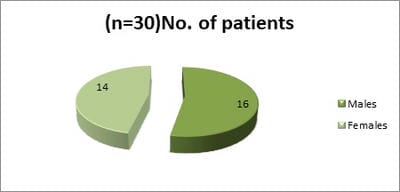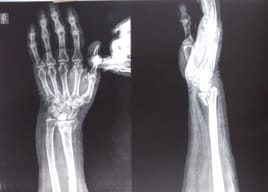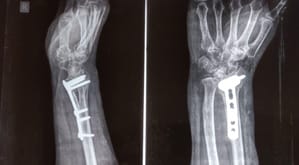Study of treatment for distal end radial fractures by open reduction and internal fixation with volar locking compression plates
Amritbhai Patel V.1, A. Pushkarna V.2*, S. Padhiyar H.3
DOI: https://doi.org/10.17511/ijoso.2020.i06.02
1 Vivek Amritbhai Patel, Associate Professor, Department of Orthopedics, Gujarat Adani Institute of Medical Science, Kutch, Gujarat, India.
2* Vishal A. Pushkarna, Assistant Professor, Department of Orthopedics, Gujarat Adani Institute of Medical Science, Kutch, Gujarat, India.
3 Hardik S. Padhiyar, Post Graduate Student, Department of Orthopedics, Gujarat Adani Institute of Medical Science, Kutch, Gujarat, India.
Introduction: For dorsally displaced lower end radius fractures percutaneous pinning fixation and in some studies fragment specific fixation shows their advantages. For volarly displaced fractures volarly plate fixation traditionally showed good results. The volar locking plates with their inheritance ability to provide absolute stability are attractive for their advantages. Objective: To assess the functional outcome of treating the distal end radius fractures with the use of volar locking compression plates. Materials and methods: Study of a total of 30 patients was conducted in the department of orthopedics at G K General Hospital, Bhuj, Gujarat. All 30 patients with closed fractures were included in the study. All patients were treated with open reduction and internal fixation with the use of a volar locking compression plate. The patients were followed up at one, two, three, and up to six months. Mayo wrist scoring system was used to assess final functional outcomes of treatment. Results: At the final functional assessment, as per mayo wrist scoring out of a total of 30 patients, 17 of them achieved excellent, 7 achieved good outcomes, with 5 patients exhibiting fair results and one patient had the collapse of fixation at the 3-month review. No, any patient had diminution of functional outcome. On radiological assessment, 70% of patients had callus formation and no clear fracture line was seen, 18% had callus formation but a visible fracture line was present and 12% of patients had clear visible fracture line up to final follow up. Conclusion: Open reduction and internal fixation with volar locking compression plating is a safe and effective treatment for unstable especially volarly displaced fractures of distal end radius with satisfactory functional outcome.
Keywords: Distal Radius, Fractures, Locking Plates, Volar locking compression plates
| Corresponding Author | How to Cite this Article | To Browse |
|---|---|---|
| , Assistant Professor, Department of Orthopedics, Gujarat Adani Institute of Medical Science, Kutch, Gujarat, India. Email: |
Patel VA, Pushkarna VA, Padhiyar HS. Study of treatment for distal end radial fractures by open reduction and internal fixation with volar locking compression plates. Surgical Rev Int J Surg Trauma Orthoped. 2020;6(6):347-353. Available From https://surgical.medresearch.in/index.php/ijoso/article/view/212 |


 ©
© 











